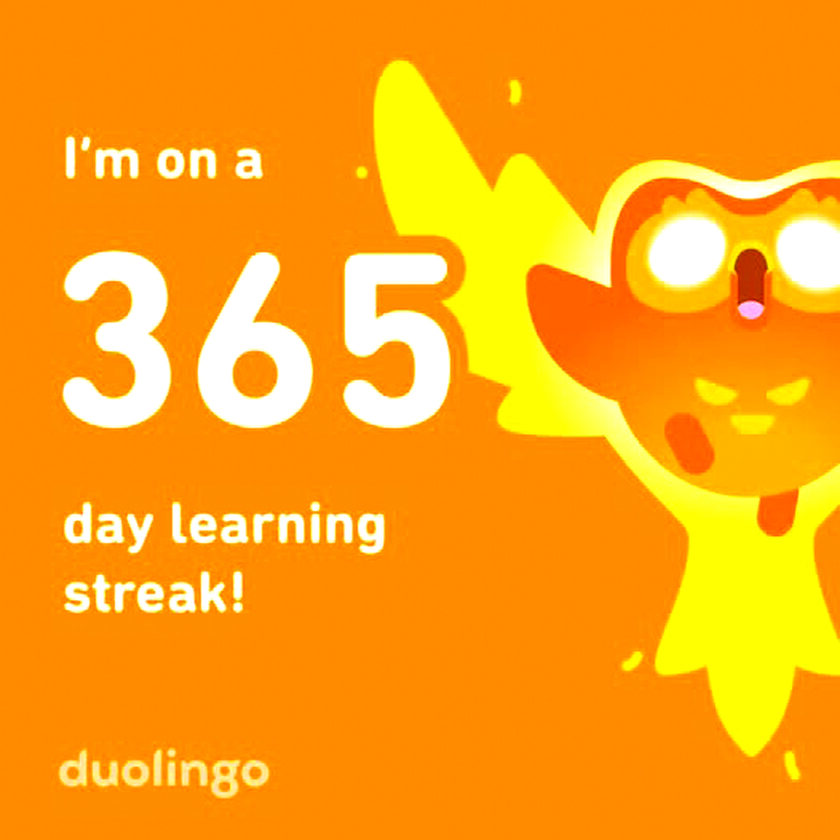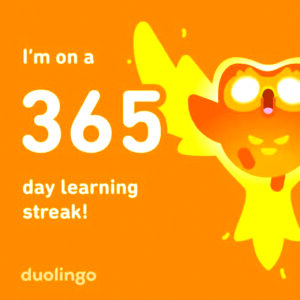10 things I learned from one year on Duolingo
- Photo by ERIN THOMPSON Celebrating 365 days on the Duolingo app.
- Photo by ERIN THOMPSON The sunset on Ometepe Island, from a February trip to Nicaragua.

Photo by ERIN THOMPSON Celebrating 365 days on the Duolingo app.
Just about 14 months ago, I committed myself to embarking on what many would describe as an unconventional adventure.
I booked a flight to San José, Costa Rica, with intentions of crossing the border into Nicaragua — two weeks of beaches, colonial towns, and volcano hikes. My Spanish, however, consisted mostly of “hola,” “gracias,” and the kind of phrases you half-remember from high school before promptly forgetting them. Still, I was determined to make it work.
My boyfriend, who grew up in Southern California and would take weekend trips to Mexico, knew more — but not much. Between the two of us, we could order a taco, ask for water, and say thank you. That didn’t stop us.
But before I left, I wanted to attempt to learn the language.
I tried a few different “teach yourself” type lessons and just found myself frustrated. I felt I wasn’t learning as quickly as I should be. That’s when I “discovered” Duolingo — an app designed to make learning a new language feel like playing a game.

Photo by ERIN THOMPSON The sunset on Ometepe Island, from a February trip to Nicaragua.
This week, I celebrated 365 days on the app. Here are 10 things I’ve learned from the experience.
1. It takes time.
Sure, I’m not learning as quickly as I would if I were taking formal lessons, but I feel much more confident about having basic conversations than I did when I left for Nicaragua. Everywhere we went throughout our trip, from the colonial streets of Granada to the breathtaking Mombacho Volcano, people were more than gracious. They commended our bravery for trying and that in itself was reassuring. I’m not going to pretend that I didn’t get a crash course in Google Translate. Yes, there were times when I ordered rice and beans when I probably would have liked something else. More often, I pointed to what I wanted on the menu. “No comprende” and “gracias” come in handy for those moments. If I were to do it again, I can actually say things like “¿Dónde está el mercado?” and understand the answer well enough to find my way there. Progress.
2. You get out what you put in.
I don’t have a ton of free time. Between work, errands, running my own business, taking care of a 200 year old building and attempting to remember where I left my coffee mug, the days go fast. But Duolingo’s little green owl makes sure I don’t forget. The reminders are oddly persistent.
“It’s time for your Spanish lesson!” feels less like encouragement and more like guilt with feathers.
Still, one short lesson a day doesn’t seem like much, but over 365 days, those small efforts add up. “Un poquito cada día,” as they say — a little bit each day.
3. It’s a game — and should be treated as such.
Duolingo is fun, but it’s not a replacement for a teacher or textbook. If you need to be fluent for work or school, this probably isn’t your only tool. But for me — a traveler trying to connect, not just communicate — it’s perfect.
It’s forgiving when I mix up tengo hambre (“I’m hungry”) and tengo hombre (“I have a man”), which would likely raise and eyebrow if it was said in a restaurant.
4. Verb tenses are tricky.
Even as someone who works with words for a living, I’ve learned that verb tenses in Spanish are their own kind of chaos. I can confidently say “Yo como” (“I eat”), but once we start adding layers like “I would have eaten” or “I was eating,” my brain checks out.
5. The streak becomes oddly sacred.
At first, I thought keeping a “streak” was silly. Then one night at 11:56 p.m., I found myself doing a quick lesson in bed so I wouldn’t break it.
Now I understand the power of habit — and mild panic. “Solo una lección más” (“Just one more lesson”) has become my nightly ritual.
6. You learn more from repetition
than you think.
If I never have to translate “La manzana es roja” (“The apple is red”) again, it’ll be too soon. But somehow, those simple sentences stick. They build confidence — and a weird attachment to apples.
7. A little competition doesn’t hurt.
There are leagues, leaderboards and points — and I’ll admit, I’ve gotten a little too invested in beating “Carlos_85.” When you see a stranger’s username ahead of yours, suddenly you’re whispering, “No, señor, yo soy el campeón.” (“No, sir, I am the champion.”)
8. You start thinking in the new language — just a little.
At first, I translated everything back to English in my head. But lately, some words just appear naturally — gracias, mañana, espera.
It’s subtle, but it’s happening. When I realized I’d just counted something in Spanish without thinking — “uno, dos, tres” — I actually smiled out loud.
9. Learning a language is about connection.
In Nicaragua, I could order food or ask for directions, but the real joy came from connecting with people, even in short, imperfect exchanges.
As an introvert, I have a difficult time socializing. But when immersed in a new culture, I would’ve been wasting my time if I didn’t try. I’m awkward, sarcastic and generally uncomfortable in most situations. Duolingo wasn’t particularly helpful in these situations. When I needed to answer someone and didn’t have time to search my brain bank for the words I needed, Google Translate filled in the gaps (thank goodness!).
10. It’s okay to learn slowly.
After a year, I’m far from fluent. If I found myself planted in Managua tomorrow, I would still freeze if someone spoke too fast and I still mix up “ser” and “estar.” But I understand more, I speak more, and I try more.
And that’s the beauty of it — consistency beats perfection.
“Despacio, pero seguro,” as the saying goes — slowly, but surely.



